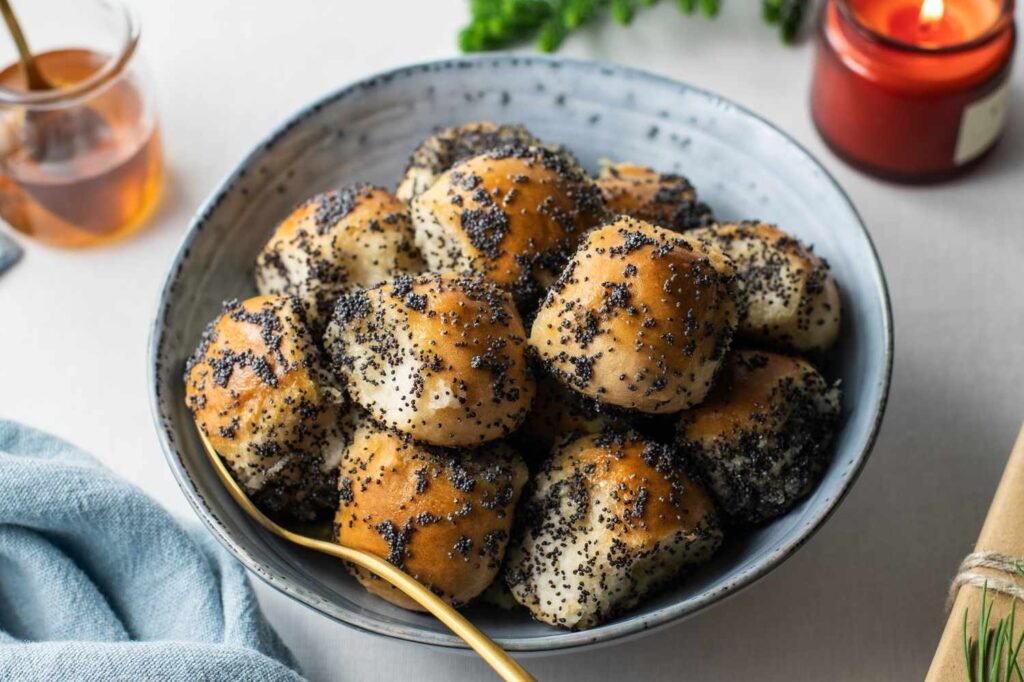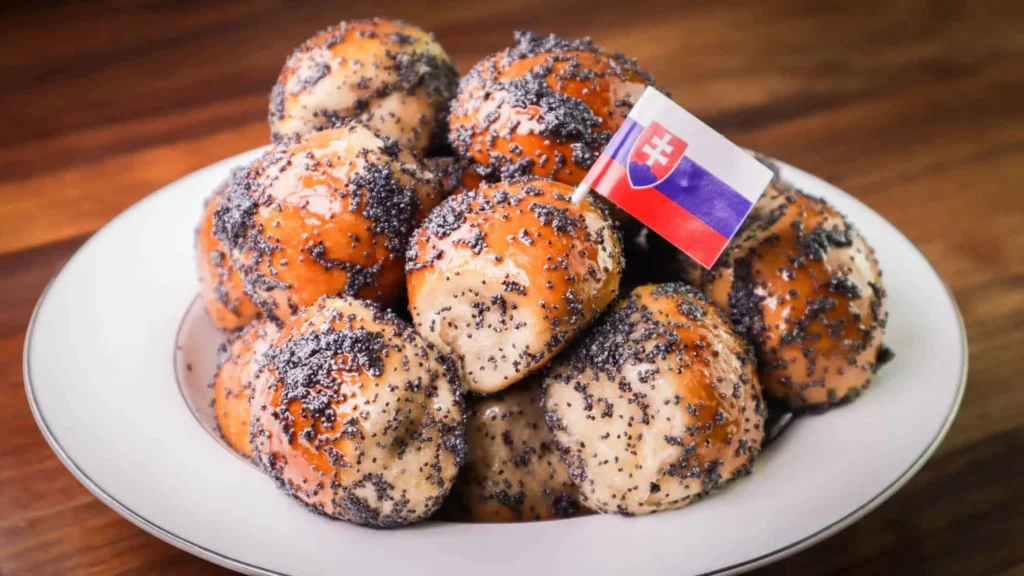May 15, 2025
Sourdough Bobalki: A Traditional Slovak Christmas Eve Delight for 2025
The Cultural Roots of Bobalki
Bobalki trace their origins to Eastern European culinary traditions, particularly in Slovakia and parts of the Czech Republic, Ukraine, and Poland. Rooted in the meatless Christmas Eve meal, which symbolizes the twelve apostles or the months of the year, Bobalki are a humble yet profound dish. Historically, they were made from simple ingredients—flour, water, yeast, and salt—reflecting the resourcefulness of rural households. The dough balls were baked until crisp, softened with hot water or milk, and dressed with local toppings like poppy seeds, honey, or sauerkraut, which held symbolic meanings: poppy seeds for prosperity, honey for vitality, and sauerkraut for resilience.
The use of sourdough in Bobalki, while less common traditionally, aligns with 2025’s global sourdough resurgence, as seen in recipes from Zesty South Indian Kitchen and posts on X. Sourdough adds a tangy complexity and longer shelf life, enhancing the dish’s rustic appeal. In Slovak folklore, Bobalki were sometimes thrown onto the ceiling during the Velija, with the number of sticking pieces predicting months of good luck or bountiful harvests—a playful tradition that underscores their role in fostering joy and togetherness. Today, Bobalki remain a bridge to the past, connecting generations through shared recipes and holiday rituals.
The Sourdough Bobalki Recipe
This recipe yields about 20–25 Bobalki, serving 4–6 as a side or dessert, and takes approximately 12–14 hours, including overnight fermentation, with active prep time of about 1 hour. It’s vegetarian, adaptable to vegan diets, and uses a stiff sourdough starter for structure and flavor. Below are detailed steps, ingredient notes, and pro tips for success, inspired by sources like Zesty South Indian Kitchen and Bakes and Blunders.
Ingredients
For the Dough:
- Stiff Sourdough Starter: 100g (50% hydration, fed 8–12 hours prior)
- All-Purpose Flour: 300g (about 2 cups)
- Milk: ¾ cup, lukewarm (plant-based for vegan)
- Butter: 2 tbsp, melted (or vegetable oil for vegan)
- Sugar: 2 tbsp, granulated
- Salt: ½ tsp
- Water: 2–3 tbsp, as needed for dough consistency
For the Sweet Topping:
- Honey: ⅓ cup, warmed (raw preferred)
- Poppy Seeds: ¼ cup, whole or lightly crushed
- Hot Water: ¼–½ cup, for softening
For the Savory Topping (Optional):
- Sauerkraut: 1 cup, rinsed and drained
- Onion: 1 medium, finely chopped
- Olive Oil: 2 tbsp
- Caraway Seeds: ½ tsp (optional)
- Salt and Pepper: To taste
Equipment
- Large mixing bowl or stand mixer with dough hook
- Measuring cups and spoons
- Kitchen scale (for precision)
- Baking sheet, parchment-lined
- Colander
- Small saucepan (for toppings)
- Microwave-safe bowl (optional, for steaming)
Instructions
- Prepare the Dough: In a large bowl or stand mixer, combine stiff sourdough starter, melted butter, sugar, salt, and lukewarm milk. Mix until smooth. Gradually add flour, mixing until a soft, supple dough forms. If too dry, add water 1 tbsp at a time. Knead for 7–10 minutes by hand or 5–7 minutes in a mixer until the dough passes the windowpane test (stretch a small piece until light passes through without tearing).
- First Fermentation: Shape the dough into a ball, place in a lightly oiled bowl, cover, and let ferment at room temperature (76°F) for 8–12 hours or overnight, until doubled in size. For a warmer or cooler kitchen, adjust timing (6–8 hours at 80°F, 12–14 hours at 70°F).
- Shape the Bobalki: Punch down the dough and turn onto a lightly floured surface. Divide into 20–25 equal pieces (about 30g each). Roll each piece into a smooth ball, about 1 inch in diameter. Place on a parchment-lined baking sheet, ensuring they touch slightly. Cover loosely with a damp cloth.
- Second Proof: Let the dough balls proof for 1–2 hours at 76°F until puffy and slightly risen. Preheat the oven to 375°F during the final 30 minutes.
- Bake: Bake for 15–18 minutes, until golden brown and cooked through. Remove from the oven and let cool completely on a rack, about 30 minutes.
- Soften the Bobalki: Break the cooled balls apart and place in a colander. Sprinkle with ¼–½ cup hot (not boiling) water to soften slightly, ensuring they don’t become mushy. Alternatively, place in a microwave-safe bowl, sprinkle with water, and steam in the microwave for 20–30 seconds. Drain well.
- Prepare Sweet Topping: In a small bowl, warm honey until runny. Mix with poppy seeds. Pour over the softened Bobalki, tossing gently to coat evenly.
- Prepare Savory Topping (Optional): In a medium skillet, heat olive oil over medium-low. Add chopped onions and caraway seeds, sautéing until soft and golden, about 8 minutes. Add sauerkraut, season with salt and pepper, and cook until warmed through, about 5 minutes. Toss with softened Bobalki.
- Serve: Transfer to a serving bowl or platter. Serve warm, garnished with extra poppy seeds or sauerkraut for flair. For the sweet version, drizzle with additional honey if desired.

Yield and Timing
- Servings: 4–6 (20–25 Bobalki)
- Prep Time: 1 hour (active)
- Fermentation and Proofing: 10–14 hours
- Cook Time: 15–18 minutes
- Total Time: ~12–14 hours
Nutritional Information (Per Serving, Approximate, for 6 servings, Sweet Version)
- Calories: 220 kcal
- Protein: 5g
- Fat: 6g
- Carbohydrates: 38g
- Sodium: 150mg
Note: Values vary based on toppings and portion size.
Tips for Success
- Use a Stiff Starter: A 50% hydration starter (equal parts flour and water by weight) provides structure and flavor. Feed it 8–12 hours before mixing to ensure it’s active and bubbly.
- Control Water for Softening: Sprinkle hot water gradually to soften Bobalki without making them soggy. Test with a small batch first.
- Knead Thoroughly: Achieving the windowpane test ensures a light, airy texture, critical for sourdough’s slow fermentation.
- Adjust Fermentation: If your kitchen is cold, place the dough in a turned-off oven with a bowl of warm water to maintain 76–80°F.
- Source Quality Ingredients: Use raw honey for the sweet topping and fresh, tangy sauerkraut for the savory version to elevate flavors.
Variations and Serving Ideas
Bobalki’s versatility allows for creative adaptations, accommodating dietary needs and personal tastes. Here are popular variations and serving suggestions to enhance your holiday table.
Variations
- Vegan: Use plant-based milk (oat or almond) and replace butter with vegetable oil. Swap honey for maple syrup or simple syrup with lemon juice.
- Gluten-Free: This recipe relies on wheat flour for structure, but you can experiment with gluten-free sourdough blends, adjusting hydration and fermentation times.
- Nutty Twist: For the sweet version, add crushed walnuts or almonds to the honey-poppy seed mix for extra crunch.
- Spicy Savory: Incorporate diced jalapeño or red pepper flakes into the sauerkraut topping for a modern kick.
- Cheese-Enhanced: Toss savory Bobalki with crumbled farmer’s cheese or feta for a creamy, tangy finish.
- Quick Version: Use frozen bread dough for a shortcut, though sourdough offers superior flavor and texture.
Serving Suggestions
- Christmas Eve Velija: Serve as part of the 12-course meatless meal, alongside mushroom soup, pierogi, and pickled fish, to honor Slovak tradition.
- Dessert Course: Offer sweet Bobalki with a dusting of powdered sugar and a cup of mulled wine or hot tea for a festive close.
- Side Dish: Pair savory Bobalki with roasted vegetables or a lentil stew for a hearty holiday spread.
- Party Platter: Arrange both sweet and savory Bobalki on a platter with dipping sauces like garlic butter or spiced honey for a communal appetizer.
- Breakfast Treat: Repurpose leftovers by warming sweet Bobalki and serving with yogurt or fruit compote for a festive morning dish.
Cultural Significance and Modern Appeal
Bobalki are more than a dish—they’re a cultural cornerstone. In Slovak homes, the Velija is a sacred ritual, with each dish carrying symbolic weight. Bobalki, representing abundance and unity, are often placed in a central bowl, encouraging shared scoops and stories. The pre-Christian practice of scattering poppy seeds to ward off evil spirits or leaving Bobalki on a windowsill for ancestral spirits adds a mystical layer, blending pagan and Christian traditions.
In 2025, Bobalki resonate with the global sourdough movement, where bakers on platforms like X and Reddit share tips for perfect starters and artisanal breads. The dish’s simplicity—relying on pantry staples—makes it accessible, costing about $0.50 per serving, while its hands-on preparation appeals to those seeking mindful cooking experiences. Its adaptability, from sweet to savory, ensures it fits modern diets, from vegan to flexitarian, while its rustic aesthetic makes it a social media star, perfect for #HolidayBaking posts.
Health Benefits and Dietary Considerations
Sourdough Bobalki offer nutritional benefits:
- Digestibility: Sourdough’s fermentation breaks down gluten and phytic acid, improving digestibility and nutrient absorption.
- Fiber and Protein: Poppy seeds and whole-grain flour (if substituted) provide fiber and protein for satiety.
- Probiotics: Sourdough may support gut health due to its natural fermentation, though baking reduces live cultures.
- Low Sugar: The sweet version uses minimal honey, keeping sugar moderate.
To tailor to specific diets:
- Vegan: Use plant-based milk, oil, and maple syrup, as noted in variations.
- Low-Sodium: Reduce salt in the dough and use low-sodium sauerkraut for the savory version.
- Gluten-Free: Experiment with gluten-free sourdough starters, though results may vary due to dough structure needs.
- Low-Fat: Replace butter with a smaller amount of oil and use less honey in the topping.
Pair Bobalki with a post-dinner walk, as promoted by National Walking Day (April 2, 2025). A 30-minute stroll burns 150–200 calories, enhancing the meal’s light, wholesome feel.
Storage and Make-Ahead Tips
Bobalki are ideal for holiday prep:
- Make Ahead: Prepare and bake dough balls 1–2 days in advance, storing in an airtight container at room temperature. Soften and add toppings just before serving.
- Storage: Store assembled Bobalki (with toppings) in the fridge for up to 3 days. Reheat gently in a microwave or oven to restore texture.
- Freezing: Freeze baked, uncoated dough balls for up to 3 months. Thaw at room temperature, then soften and top as directed.
- Repurposing: Use leftover sweet Bobalki in bread pudding or savory ones in a casserole with cheese and herbs.
Community and Social Engagement
Bobalki are perfect for holiday gatherings, fostering connection through shared traditions. Post your creations on social media with hashtags like #SourdoughBobalki or #SlovakChristmas to join a global community of bakers. Engage on platforms like Reddit’s r/Breadit or X, sharing tips like using a spice grinder for finer poppy seeds or adding orange zest to the sweet topping. Host a “Velija Tasting Night,” inviting guests to sample Bobalki alongside other Eastern European dishes like pierogi or kutia, creating a festive, cultural experience.

Conclusion
Sourdough Bobalki are a celebration of Slovak heritage, artisanal baking, and holiday joy. Their golden, tangy dough balls, kissed with honey and poppy seeds or savory sauerkraut, bring warmth and meaning to the Christmas Eve table. Rooted in centuries-old traditions and elevated by modern sourdough techniques, they’re a standout in 2025’s culinary landscape, blending nostalgia with craft. Whether you’re honoring family recipes or discovering Bobalki for the first time, this dish offers a taste of unity and abundance.
More Details